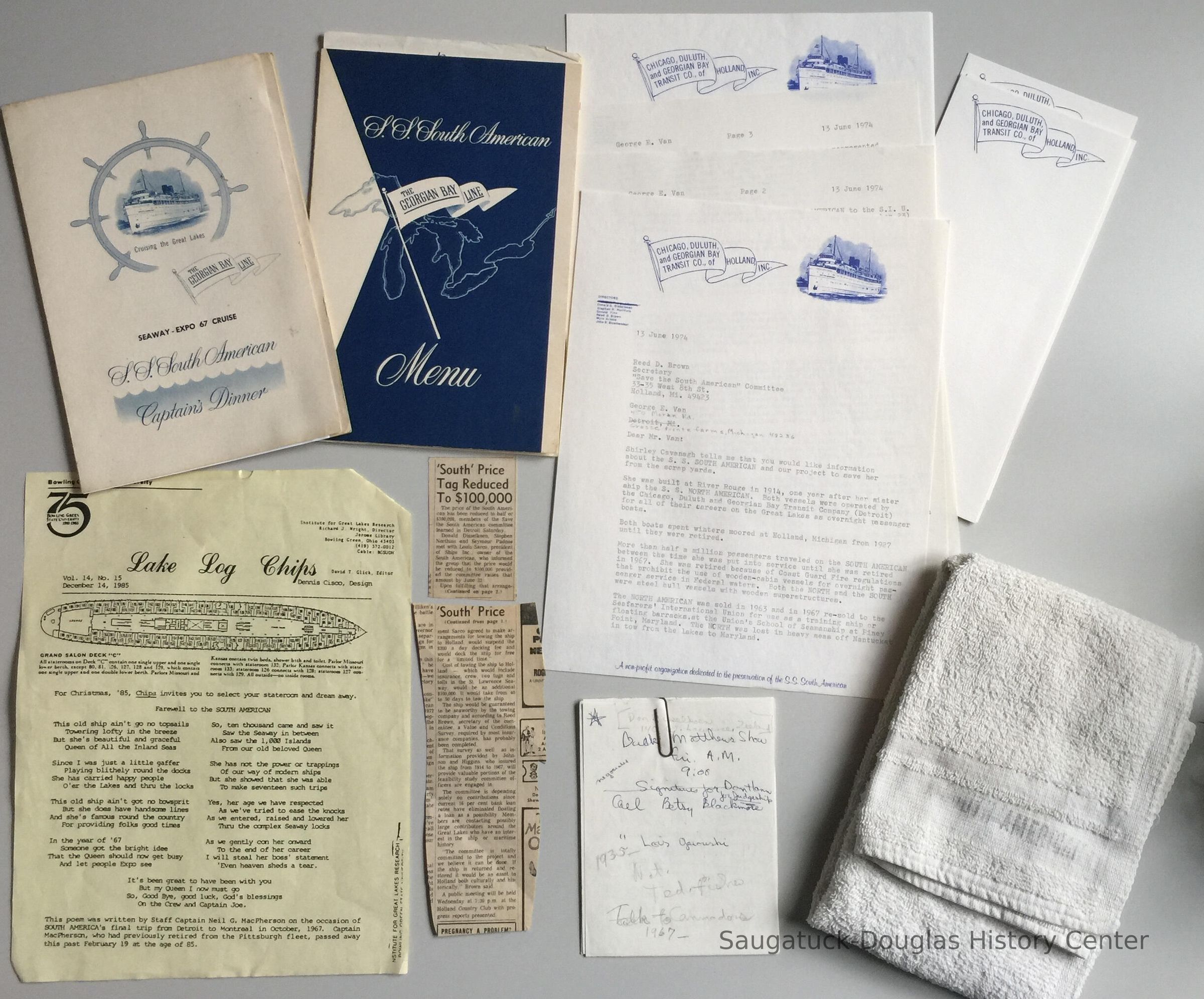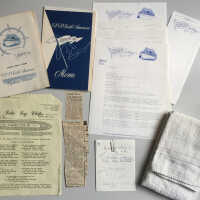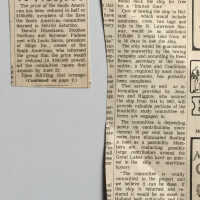S.S. South American items

2021.76.05
Nautical1880 Tourism steamship era -1930
Winthers, Sally
Letter from Reed D. Brown
3-page letter from Reed D. Brown, Secretary of the Save the South American committee, to George E. Van recounting the ship's history and efforts to save it. Including Mr. Brown, other members of the committee are listed on the letterhead as Donald G. Disselkoen, Stephen R. Northuis, Donald Finn, Myra Arnold and John R. Bloemendaal.
Jun 13, 1974
Letterhead and envelopes
Blank 8.5x11" letterhead and #10 envelopes Imprinted Chicago, Duluth, and Georgian Bay Transit Co., of Holland, Inc. pennant logo
Lake Log Chips copy
Yellow sheet of paper with xeroxed invitation to "For Christmas, '85 Chips invites you to select your stateroom and dream away." "Lake Log Chips" was a weekly news sheet about current events on the Great Lakes, published by the Institute for Great Lakes Research, Bowling Green State University in Ohio. Flyer includes diagram of Grand Salon Dec "C" and "Farewell to the South American" poem by Staff Captain Neil G. MacPherson (?-1985) written for the ships final trip from Detroit to Montreal in October 1967.
Glick, David, T.
Dec 14, 1985
Captain's Dinner Menu
Two slightly different menus with codes SDC-2-69 or CD-EXPO-67 on the bottom of menu listings page. The menus are printed in blue ink on card stock with a slightly off-center fold for ease of opening. The cover has an image of the ship inside a drawing of a ship's steering wheel, along with the logo pennant. "Seaway-Expo 67 Cruise" has been overprinted in black ink. The menu's offerings were typical mid-century "fine" dining with radish roses, olives, celery, iced tomato juice and sardines in oil for starters. Sanka and buttermilk were offered after the cheese course. The captain is Joseph A. Testyon, Master. President E.J. Goebel, N.L. Chinnock, Passenger Traffic Manager.
1967
Dinner Menu
A less elaborate menu with a blue cover and marked with the code RD-67-F
Stationary
9.5x6" on board stationary and matching #6 envelope printed with blue and red logos
Notes
Stack of five pages of 5.5x4.25" notes, handwritten in multiple pens and pencils with names and addresses and lists
Newspaper Clipping
Headline " 'South' Price Tag Reduced To $100,000" from unknown publication. Article names Save the South American committee members Donald Disselkoen, Stephen Northuis and Seymour Padnos meeting with Louis Sarco, president of Ships, Inc., owner of South American. Article photocopied for archiving purposes. Original, aging newsprint not saved.
towel
White terrycloth towel measuring 24x16.5" with "South American" stamped in black on a flat-weave stripe along the edge of the cloth.
162 SS South and North American
South American (ship)
Shirley Cavanagh tells me that you would like information about the S. S. SOUTH AMERICAN and our project to save her from the scrap yards. She was built at River Rouge in 1914, one year after her sister ship the S. S. NORTH AMERICAN. Both vessels were operated by the Chicago, Duluth and Georgian Bay Transit Company (Detroit) for all of their careers on the Great Lakes as overnight passenger boats. Both boats spent winters moored at Holland, Michigan from 1927 until they were retired. More than half a million passengers traveled on the SOUTH AMERICAN between the time she was put into service until she was retired in 1967. She was retired because of Coast Guard Fire regulations that prohibit the use of wooden-cabin vessels for overnight passenger service in Federal waters. Both the NORTH and the SOUTH were steel hull vessels with wooden superstructures. The NORTH AMERICAN was sold in 1963 and in 1967 re-sold to the Seafarers' International Union for use as a training ship or floating barracks at the Union's School of Seamanship at Piney Point, Maryland. The NORTH was lost in heavy seas off Nantucket in tow from the lakes to Maryland. The Georgian Bay Line then sold the SOUTH AMERICAN to the S.I. U. and decommissioned her at the end of the 1967 season (October 23) at Montreal. The 321-foot, 450 passenger vessel had pliled the lower lakes and the Seaway between Detroit and Montreal that last year, carrying passengers to Expo '67. The S.I.U. tried to use the SOUTH AMERICAN as floating barracks, but largely because of the Coast Guard fire codes, could not. She sat, subject to vandals, at a shipyard in Norfolk, Va. from about 1968 or '69 until earlier this year when the S.I.U. sold her. A local man in Holland saw an ad in a shipping trade magazine for the vessel in January and interested the local Jaycees chapter in spearheading a community project to bring the back to Holland. Before that could really "get off the ground", it was learned that the SOUTH AMERICAN had been sold to Ships, Inc, a salvage yard at Camden, New Jersey. A committee, under the auspices of the Jaycees, was immediately formed (May 6) and a delegation of committee members and Jaycees went to Camden to inspect the ship and talk to Ships, Inc. on May 13th. The boat is in very good condition, considering her age and the fact that she was neglected in salt water for several years. The committee has located most collectable artifacts that were removed from the boat over the last few years and believes she can be restored. An east-coast towing firm, McAllister, has agreed to tow her back to Holland harbor. She is seaworthy. Terms of the purchase by the committee, to become the Chicago, Duluth and Georgian Bay Transit Co. of Holland, Inc. by the end of this week, are $100,000 in cash on June 22, 1974. Otherwise the president of Ships, Inc., Louis Sarko, will proceed to cut her up for scrap. Another $100,000 is being asked by Mr. Sarko within two years, with no interest. It would cost the committee $100,000 to have the ship towed to Holland from Camden. She is a long way from home. So we are talking about $200,000 to buy the ship and have her towed home this summer. Other expenses would follow in restoration and in further payments to Ships, Inc. We propose to use the ship as a maritime museum, an art gallery (which Holland has never had), a restaurant, meeting facilities, and a cabaret-style theater. We have committed ourselves to having a formal feasibility study made with regard to the possibilities for our plans, the actual condition of the vessel and her potential for remodeling. Mr. Sarko's deadline of June 22, 1974 for the purchase has placed us in, to say the least, an uncomfortable situation. We had not asked for any contributions for purchase of the ship until that deadline was handed to us on June 8. Sarko will guarantee the condition of the ship as represented to us, that being that it is structurally sound in all areas except the topmost deck and that the hull is in excellent condition. Our position is that the guarantee must be in writing at the time of purchase. After the deadline of June 22 has been met, if in fact we can make it, then the studies will be conducted. If the studies do not prove that the ship is satisfactory for our purposes, we would then get our money back and return it to the contributors. We are confident, however, that the studies will show that the ship is in good shape and that we can do what we want to do with her. The prices quoted are reasonable insofar as we can determine, based on the scran value of the vessel and going towing rates. We are seeking and have sought the aid of insurance and banking people in addition to legal aid both locally and in Detroit. People in Detroit have been extremely helpful to our project. Former Georgian Bay Line officials have also been most helpful. Our committee and the soon-to-be C. D. & G. B. T. Co. of Holland is strictly non-profit. Any commercial ventures placed aboard the vessel at a future time would be on a lease or franchise basis with all proceeds to the company used for maintenance of the ship and for promotion. The committee is composed of about a dozen Holland citizens, both active and supportive. It must be understood clearly that we do not yet have tax-exempt status with the I-R-S. Our articles of incorporation are just being filed. We have had to move so quickly to this point of purchasing the vessel that in some instances we are almost ahead of ourselves. We have not, however, moved recklessly or without deliberation. We have met and worked almost daily since May 6 as a committee and as individuals. Each of us has taken time off from our jobs to work on the project and have footed many expenses out of our own pockets; thus we are spending our own money with only the hope of seeing this last existing Great Lakes cruise ship of American registry saved from destruction. The S. S. SOUTH AMERICAN was called the queen of the Great Lakes and the Great White Liner during her career on the lakes. Ads in Detroit newspapers for cruises aboard her and the old NORTH advertised the Great Oil Fired White Liners. In the Georgian Bay Colors (white with red and gold trim) the SOUTH AMERICAN was a beautiful sight. She still is, although she needs paint inside and out. She is the very last of her breed and we think she deserves a dignified retirement, not the scrap yards. She is still useful to the entire Great Lakes community as a reminder of where we went to attain the height of civilization (?) we have. Please call at any time if you have further questions. We appreciate your help in saving the S.S. South American. Sincerely, Reed D. Brown
11/04/2021
10/19/2022


